Pau 作者: 来源: 发布时间:2021-09-26
I.Population and Area
Region: Aquitaine
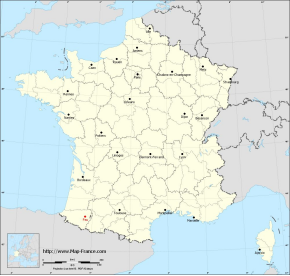
Department: Pyrénées-Atlantiques
Code Insee : 64445
Code postal :64000
Total Area: 31.51 km²
Population in 2017: 77 130
Population Density: 2300 /km²
Location: Pau is 100 kilometres from the Atlantic Ocean and 50 km from the Pyrenees. Spain is 50 km (31 mi) away as the crow flies. The frontier is crossed by the col du Somport (1,631 metres (5,351 feet)) and the col du Pourtalet (1,794 m (5,886 ft)). Access to the crossings partly accounts for Pau's strategic importance. Pau is located 200 km (124 mi) west of Toulouse, 30 km (19 mi) from Tarbes and Lourdes, 25 km (16 mi) from Oloron. The conglomeration of Bayonne-Anglet-Biarritz is at 110 km (68 mi), Bordeaux 190 km (118 mi). Pau is surrounded by the communes Buros, Montardon, Morlaàs, Bizanos, Idron, Gelos, Jurançon,Lons and Billère.
Histogram of demographic change
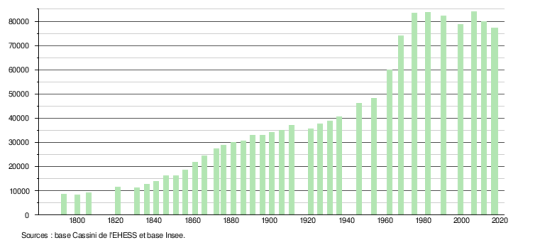
Sources :http://www.cartesfrance.fr/carte-france-ville/64445_Pau.html
II.Natural Geography

Geographical environment: Pau is a commune in southwestern France, in the region of Nouvelle-Aquitaine. It is the prefecture (capital) of the Pyrénées-Atlantiques department. It is also the capital of 6 cantons in the department: Jurançon, Pau-Centre, Pau-Est, Pau-Nord, Pau-Ouest and Pau-Sud. Pau is the second city of Aquitaine, after Bordeaux. Pau was also the capital of the old historical province of Béarn. It stands on the edge of a plateau 130 feet (40 metres) above the valley of the Pau Stream, which descends from the Pyrenees.
Climat: The climate of Pau is Marine West Coast Climate, with mild winters and warm summers. The average temperature for the year in Pau is 13.5 °C (56.3 °F). The warmest month, on average, is July with an average temperature of 20.7 °C (69.3 °F). The coolest month on average is January, with an average temperature of 6.6 °C (43.9 °F). The average amount of precipitation for the year in Pau is 1,051.6 mm (41.4 in). The month with the most precipitation on average is December with 104.1 mm (4.1 in) of precipitation. The month with the least precipitation on average is February with an average of 73.7 mm (2.9 in).
Natural environment and biodiversity: Due to Pau's huge hydrological network and high-quality natural environment, its species are diverse. There are kinds of animals, include mussels, Oxygastra curtisii, Gomphus graslinii, Austropotamobius pallipes, Lampetra, Salmo salar and Cottus gobio,etc. Besides, in the park of Pau Castle, there are a lot of old trees. It is also the only known source of the Pyrénées-Atlantiques spiny beetle (Osmoderma eremita), a species that is declining, threatened and protected.
Transport:
(1)Traffic in the city: The Idelis + network, operated by the Société des transports de l'Agglomération Pau (STAP), serves Pau’s and its surrounding traffic. More than 8.5 million trips are made each year on this network in 2017.
(2) Trains: Several categories of trains connect Pau station to other French or European urban centers. These are the TGVs, which link Paris-Montparnasse to Tarbes; Intercités, which connect
Hendaye to Toulouse-Matabiau; TER, which notably link Bordeaux-Saint-Jean to Tarbes. Two railway construction projects have been under study since the early 2000s: a high-speed line from Bordeaux to Spain via the east of the Landes, the work of which should be completed in 2032, and the reopening of the cross-border link Pau-Canfranc (Spain) which would link Pau to Zaragoza. The Pau funicular, inaugurated in 1908, provides a free connection between the station district and Boulevard des Pyrénées. In 2017, it carried an average of 500,000 passengers per year, and was in operation everyday.
(2)Airport: Pau-Pyrénées Airport, located 12 km away in the town of Uzein, is directly connected to Paris-Charles-de-Gaulle and Paris-Orly airports (9 round trips per day), to Lyon (3 round trips returns per day), Marseille and Nantes (9 connections per week), Marrakech (1 to 2 connections per week), as well as Strasbourg, Lille, Brest, Quimper, Metz, Nice or Ajaccio in seasonal connections. In 2018, it recorded 612,580 passengers.
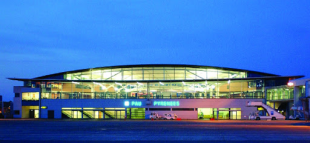
Sources : https://www.britannica.com/place/Pau
III.Economy
Income: According to Insee, in 2014, the inhabitants of Pau earn on average € 2 458 net per month, or € 29 492 net per year.
Jobs: In 2016, the population aged 15 to 64 amounted to 49,613 people, among which there were 68.1% of active people. Besides, in 2016,there were then 50,134 jobs in the employment zone.
Companies: A total of 7 093 companies are located in the city in 31 Decembre 2017, of which 1 953 are in the service industry and 327 in the industry. In 2018, 934 new companies were created, including 760 individual. More than 52% of these companies operate in the field of services to individuals or businesses
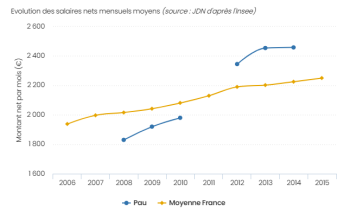
Evolution of average monthly net wages
Sources : http://www.journaldunet.com/business/salaire/pau/ville-64445
IV.Industrial Characterisitics
Pau expanded rapidly, partly through industrialization (the manufacture of aeronautical equipment, mechanical engineering, and food processing). It also serves as the administrative centre of the département. The University of Pau and the Pays de l’Ardour opened in Pau in 1970. The industrial complex at Lacq lies southeast of the town.
Lacq gas: In connection with the exploitation of Lacq gas, Pau hosts The Centre Scientifique et Technique Jean Féger (CSTJF). It is the main technical and scientific research center of the French Oil group Total SA. It is the 1st research center for the exploration and production of gas and oil in Europe, and the 3rd research center in France. It has a concentration of more than 2,800 people, including around 900 doctors. and engineers in geosciences.
The manufacture of aeronautical equipment: The creation in Pau by the Wright brothers in 1909 of the first flying school in the world sparked the enthusiasm and development of the aeronautical industry. Today, globally famous companies have settled in the region, helping to establish the aeronautical vocation of the Adour area. This is the case with Dassault-Aviation, Fouga-Potez, Safran helicopter engines (ex Turbomeca), Safran landing systems and Daher-Socata. Ex: Safran Helicopter Engines, previously known as Turbomeca, is a French manufacturer of low- and medium-power gas turbine turboshaft engines for helicopters. The company also produces gas turbine engines for aircraft and missiles, as well as turbines for land, industrial and marine applications. Since its foundation as Turbomeca during 1938, Safran Helicopter Engines has produced over 72,000 turbines.
Food and wine industry: The Pau economy is also based on the agri-food industry in the fields of maize, processed products (dairy products, canning, meat) and the wine industry (Group Euralis, Candia, Bongrain, 3A, Michaud and Miot). With 400 researchers, Pau is the first European research centre for maize-growing. Ex: The EURALIS Group is a French agricultural and food cooperative group with the four divisions: agricultural production and distribution, gastronomy and foie gras, seeds and investment and developments. It was found in 1936 by farmers and counts today 7.000 shareholders and 5 150 employees.
The electronics and electrical engineering sector also has several industrial sites in the Pau agglomeration (Legrand, Arelec, Aquitaine electronics, Siemens).
The pharmaceutical sector is growing and is represented by Pierre Fabre, Boiron, Sanofi and Finorga companies. A bio-health centre grouping of industrial pharmacy and biology was created in 2006 around the Pierre Fabre and DBI enterprises.
Sources: https://www.britannica.com/place/Pau
https://www.investinpaupyrenees.com/choisir-pau-bearn-pyrenees/secteurs-cles/aeronautique-defense-et-metallurgie/?lang=en
https://www.safran-helicopter-engines.com/
V.Attractions
1.Boulevard des Pyrénées
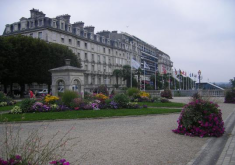
The Boulevard des Pyrénées is a boulevard in the town of Pau in the Pyrénées-Atlantiques département of south-west France. With buildings on its northern side only, and a terrace overlooking the valley of the Gave de Pau to its south, the boulevard is notable for its panoramic view of the peaks of the Pyrenees some 50 km to the south.
The boulevard was created at the suggestion of Napoleon I, and overlooks terraced gardens cascading down the valley side. In clear weather, especially early morning or late evening and in winter, the view stretches from the Pic du Midi de Bigorre to the Pic d'Anie, with the Pic du Midi d'Ossau standing out in the background. Along the railings on the terrace side of the boulevard are plaques pointing out and describing each mountain.
The boulevard runs for some three-quarters of a kilometer, linking the Parc du Beaumont to the Château de Pau and forming the southern edge of the town centre. From its centre, adjacent to the Place Royale, the Funiculaire de Pau descends to the valley bottom, linking the town centre to Pau railway station.
2.PAU CASTLE
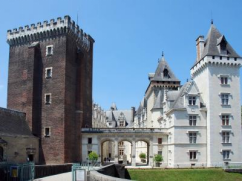
The ancient feudal fortress of the viscounts of Béarn, where Henry IV was born in 1553, and which was converted into a royal palace by Marguerite of Angouleme, sister of Francis I, and her husband Henry II of Albret, heirs to the crown of Navarro, was entirely restored in the 19th century by Louis-Philippe and Napoleon III. And it was once used by Napoleon as a holiday home during his period of power.
It is currently a National Museum which houses the works preserved from the days of Henry IV and especially during the restoration made by Louis-Philippe. It currently hosts over 100,000 visitors annually, making it the most visited heritage site of the French department of Pyrénées-Atlantiques. The museum contains a unique artistic and historical collection in an exceptional setting. On display amongst other things are a sumptuous collection of royal tapestries from the 16th to the 19th century, along with extensive collections that have been assembled since 1945 to depict the history and the legend of France’s most popular king.
Source: https://en.lourdes-infotourisme.com/web/EN/400-pau-castle.php
3.The Bernadotte Museum
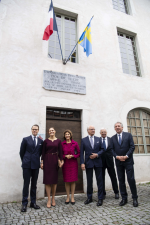
Built around 1730, the Balagué house was the birthplace of Jean-Baptiste Bernadotte, who became king of Sweden and Norway. This house, which offers a fine example of Béarnaise architecture in the city of Pau, naturally became the Bernadotte Museum. It retraces on two levels through paintings, sculptures, objects, the irresistible rise of Jean-Baptiste Bernadotte.
The municipal museum is located in the birthplace of Bernadotte, classified as a historic monument since 1953. It is a typically Béarn bourgeois building dating from the 18th century. The Balagué house offers all the characteristics of a town house from that century: construction in pebbles, bricks and freestone, wooden galleries overlooking the courtyard. The rooms bear witness to the traditional living environment of a Béarn family at the time.
On Monday October 8, 2018, the City of Pau received the Swedish royal family on the occasion of the bicentenary of the accession to the throne, their grandfather Jean-Baptiste Bernadotte. King Carl XVI Gustaf, surrounded by Queen Sylvia, Princess Victoria and Prince Daniel, inaugurated the Bernadotte Museum, which was just renovated.
4.Beaumont Park
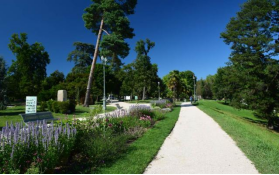
The city of Pau bought this park from the family of Countess Anna de Noailles for the sum of 800,000 F at the time. In 1898, Henri Martinet, landscape architect, redesigned it in an English style. From its alleys that converge towards the bandstand to its lake with bald cypress trees, Beaumont Park is home of beautiful trees, many of which are centuries old: evergreen redwoods from California, cedars from the Himalayas, araucarias from Argentina and Chile, trees from Judea, horse chestnut from the Balkans, magnolias. Bucolic, the Pyrenean garden recalls the mountain, its rocks, its perennials, its streams.
Beaumont Park is a place of gathering and relaxation for Palois and hosts. Nearby, on the southern slope, the Théâtre de Verdure hosts shows each year in summer, like the music festival and the Grand Prix automobile de Pau.
Source: https://www.pau-pyrenees.com/pau/parc-beaumont/tabid/315/offreid/901c73db-1413-442b-bc38-c4a6ee5754ee
5.Musée des Beaux-Arts de Pau
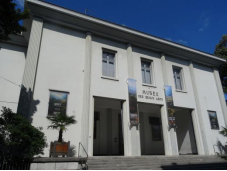
The Musée des Beaux-Arts de Pau was inaugurated in 1864 under the initiative of the Société Béarnaise des Amis des Arts, with a notable donation from the Béarn-born collector Louis La Caze in 1872. It was the first museum, in 1878, to exhibit an important work by Degas, The Cotton Office in New Orleans. It presents works ranging from the seventeenth century to the twentieth century, with painters from various European schools such as Brueghel, Jordaens, Morisot or Rubens but also regional artists such as Victor Galos. The museum has been located since 1931 in an Art Deco style building designed for it.
Two annual temporary exhibitions are on offer, such as the recent exhibition of lithographs and ceramics by Pablo Picasso, prints by impressionist artists or even abstract sculptures by Alberto Guzmán.
Throughout the year, the Museum opens and becomes accessible to all. The teaching team offers a wide range of activities suitable for everyone, like adults, young audiences, families, schools, etc.
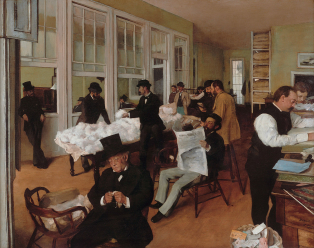
Un bureau de coton à la Nouvelle-Orléans, 1873.
Sources : https://www.pau.fr/article/le-musee-des-beauxarts-devoile-une-collection-connue-du-monde-entier
VI.History
Origin of name: The origin of the name is uncertain. One tradition suggests it is a derivation of pal, from the palisade around the original château. Another is that the name refers to a ford across the river administered by the church, the pious. In two centuries (11th and 12th centuries), Béarn becomes an important country where villages develop around their castles, as in Pau.
The rise of the city:
The city of Pau and its castle is needed in the sixteenth century becoming the seat of the kings of Navarre. Pau becomes a center of political and intellectual foreground under the reign of Henri d’Albret and his wife Marguerite.
It was during the French Revolution and following the creation of the département of the Basses Pyrénées (which became later the Pyrénées Atlantiques) that Pau regained some importance. The mild climate, which is beneficial for your health, brought in an influx of English speaking people during the 19th century. They made Pau a wealthy town by building villas and other beautiful bourgeois houses. They even built a golf course, the oldest one in France.
Pau experienced a new boom after the Second World War, this was closely linked to the discovery of natural gas deposits at Lacq, a few kilometres to the west.
Today, the town is attractive and dynamic. It has a university, business schools, high tech industrial zone and sports arena. Zénith is grounds of their first class sports teams in basketball and rugby.
Sources: https://www.investinpaupyrenees.com/vivre/histoire/?lang=en
VII.Other information
Today, the Pau heritage spans several centuries, its diversity and quality have earned it the label of city of art and history in 2011. We must stroll to Oloron Sainte-Marie, this historic city, in the episcopal city, the medieval village or Notre-Dame district. Jewel of the city, the cathedral is classified World Heritage of Humanity by UNESCO.
Pau is a particularly green city with more than 750 hectares of communal green spaces. Thanks to a mild and rather humid climate, the gardens are decorated with plants from more exotic regions such as Chinese palm trees. Pau is classified to be "4 flowers" by the National Council of cities and villages in bloom. The town prides itself on having the most green spaces per inhabitant in Europe.
VIII.Contact information
Address of Pau town hall:
Mairie de Pau
Place Royale
64036 Pau Cedex
Phone number: 05 59 27 85 80
Fax: 05 59 27 26 18
E-mail: communication@pau.fr
Website: http://www.pau.fr
Mayor : François Bayrou (Mandat : 2014-2020)
Sources : http://www.cartesfrance.fr/carte-france-ville/64445_Pau.html#mairie
